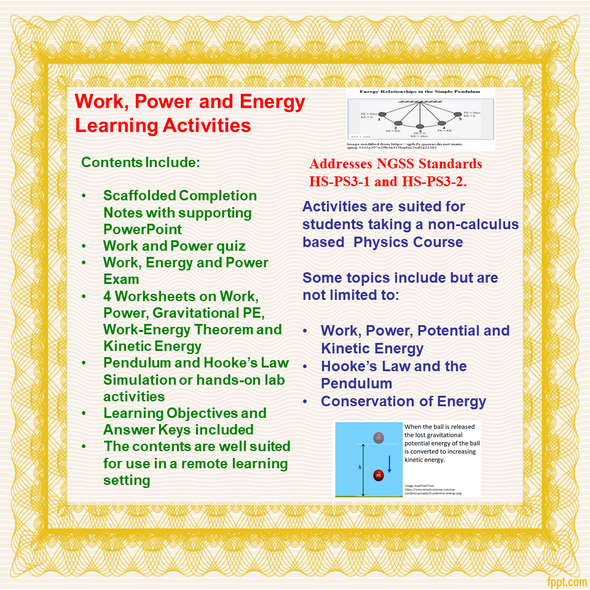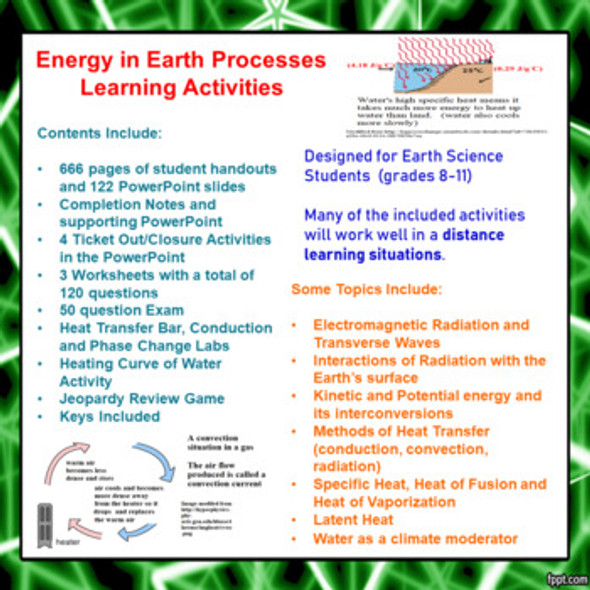Description
The Ecosystem Interactions, Energy and Dynamics Learning Activities set for Middle School Science provides the materials you need to design your unit. The activities address the topics included in NGSS learning standards MS-LS2-1, MS-LS2-2, MS-LS2-3, MS-LS2-4 and MS-LS2-5. These topics include, but are not limited to:
- Ecological Organization (population, community, ecosystem, biosphere)
- Abiotic and Biotic Factors
- Requirements for a Self-Sustaining Ecosystem
- Nutritional Terminology and Examples (herbivore, carnivore, omnivore, predator, prey, scavenger, decomposer, etc.
- Producers (autotrophs) and Consumers (heterotrophs)
- Food Chains, Food Webs and Energy Pyramids
- Symbiotic Relationships (parasitism, commensalism, mutualism)
- Competition
- Successions
- Material Cycling (carbon-oxygen and water)
- Biodiversity and Ecosystem Services
The contents of the package include three reading and writing activities, completion notes with an associated PowerPoint, as well as eight worksheets and a unit exam that total 120 pages. All materials can be easily modified to suit your specific classroom needs. The materials are well suited for use in most distance learning environments. With the exception of the PowerPoints, all activities are in both word and pdf format. Answer keys are included for all items. Specific information about the materials in this package are in the list that follows:
- Introduction to Ecology PowerPoint (107 slides) (includes 4 closure activities in the PowerPoint
- Completion Notes to accompany the PowerPoint (35 pp.)
- Ecology Jeopardy PowerPoint (26 questions) (56 slides)
- Ecological Organization, Biotic and Abiotic Factors Worksheet (32 completion and multiple choice questions) ( 5 pp.)
- Feeding Relationships Worksheet 1 (31 completion and multiple choice questions) (5 pp.)
- Feeding Relationships Worksheet 2 (40 multiple choice and written response questions) (8 pp.)
- Nutritional Terminology and Symbiotic Relationships Worksheet (27 completion and multiple choice questions) (3 pp.)
- Material Cycles Worksheet (25 multiple choice and written response questions) (7 pp.)
- Successions and Ecosystem Change Worksheet (36 questions) (8 pp.)
- Biodiversity and Ecosystem Services and Change Worksheet (44 multiple choice and written response questions) (8 pp.)
- Introduction to Ecology Crossword (1 p.)
- Population Interactions Activity (includes reading, graphing and written response questions) (13 pp.)
- Ecological Succession Reading, Graphing and Writing Activity (includes reading, graphing, data analysis and written response questions) (10 pp.)
- Introduction to Ecology Test (50 multiple choice and written response questions) (12 pp.)
- Ecosystem Services Video Worksheet (25 questions) (4 pp.)
- Learning Standards and Objectives Including NGSS and Common Core (4 pp.)
NGSS Learning Standards
MS-LS2 Ecosystems: Interactions, Energy, and Dynamics
Students who demonstrate understanding can:
MS-LS2-1. Analyze and interpret data to provide evidence for the effects of resource availability on organisms and populations of organisms in an ecosystem.
MS-LS2-2. Construct an explanation that predicts patterns of interactions among organisms across multiple ecosystems.
MS-LS2-3. Develop a model to describe the cycling of matter and flow of energy among living and nonliving parts of an ecosystem.
MS-LS2-4. Construct an argument supported by empirical evidence that changes to physical or biological components of an ecosystem affect populations.
MS-LS2-5. Evaluate competing design solutions for maintaining biodiversity and ecosystem services.
Common Core State Standards Connections:
ELA/Literacy
RST.6-8.1 Cite specific textual evidence to support analysis of science and technical texts.
RST.6-8.7 Integrate quantitative or technical information expressed in words in a text with a version of that information expressed visually (e.g., in a flowchart, diagram, model, graph, or table).
RST.6-8.8 Distinguish among facts, reasoned judgment based on research findings, and speculation in a text.
RI.8.8 Trace and evaluate the argument and specific claims in a text, assessing whether the reasoning is sound and the evidence is relevant and sufficient to support the claims.
WHST.6-8.1 Write arguments to support claims with clear reasons and relevant evidence.
Learning Objectives
Upon the completion of this unit the student will be able to:
1. define the term ecology.
2. define and list examples of the following levels of ecological organization; population, community and ecosystem.
3. define the term biosphere.
4. recognize an ecosystem requires interactions between abiotic and biotic factors.
5. define the terms abiotic and biotic factor and list examples of these.
6. define the term competition and list some examples of this.
7. define the term limiting factor and list some examples of these.
8. define the term carrying capacity.
9. describe the role of decomposer organisms.
10. list some examples of decomposer organisms.
11. list the requirements for a self-sustaining ecosystem.
12. define the term autotroph and list examples of these.
13. recognize autotrophs are also called producers.
14. define the term heterotroph and list examples of these.
15. recognize heterotrophs are also called consumers.
16. define the terms herbivore, omnivore and carnivore and list some examples of each.
17. define the terms predator and prey.
18. describe some relationships between predator and prey.
19. define the term scavenger and list examples of these.
20. define the term symbiosis and list three categories of symbiosis.
21. define the term mutualism and list some examples of this.
22. define the term commensalism and list some examples of this.
23. define the term parasitism and list some examples of this.
24. explain why it is a disadvantage for a parasite to kill its host.
25. recognize a food chain shows the transfer of energy from a producer through a series of consumers.
26. recognize producers capture solar energy and store it in the energy of glucose food.
27. describe the basic flow of energy through ecosystems.
28. utilize a food chain or food web to illustrate the flow of energy through an ecosystem.
29. recognize that a food web is a series of interrelated food chains.
30. explain why a food web provides a better representation of the feeding relationships in an ecosystem than a food chain.
31. explain what is meant by a feeding level.
32. define the term biomass.
33. recognize that an average of 90% of the energy is lost to heat and wastes when energy is transferred from one feeding level to another.
34. utilize an energy pyramid to describe the energy and feeding relationships within an ecosystem.
35. recognize due to the loss of energy between feeding levels in energy transfers, ecosystems require an input of energy from the sun.
36. recognize the more similar the requirements of organisms for a limited resource, the more intense the competition between them.
37. describe the carbon-oxygen cycle and the major processes involved with it including; photosynthesis, respiration, decomposition and the burning of fossil fuels.
38. discuss the major processes involved in the water cycle including; evaporation, transpiration, condensation, precipitation and runoff.
39. describe how some disruptions change ecosystems.
40. define the term habitat.
41. explain what is meant by strip mining and clear cutting.
42. discuss some problems associated with strip mining and clear cutting.
43. list some examples of biological disruptions of ecosystems.
44. explain what is meant by an ecological succession.
45. list some factors that influence ecological successions.
46. define pioneer organisms and list some examples of these.
47. recognize the earlier stages of successions change conditions in the ecosystem making it more favorable for succeeding stages to succeed and less favorable for themselves.
48. explain what is meant by a climax community.
49. recognize the climax community tends to change little for hundreds or thousands of years until it is disrupted.
50. recognize that once it is disrupted, a succession will tend to restore itself to a community resembling the original climax community.
51. define the term biodiversity.
52. recognize the complexity and completeness of the biodiversity in an ecosystem provides a measure of its health.
53. discuss several reasons for preserving biodiversity.
54. discuss why the lack of biodiversity may lead to species extinction.
55. define the term monoculture.
56. define the term aesthetic.
57. explain what is meant by ecosystem services.
58. discuss some human threats to biodiversity.
59. define the term biomagnification.
60. discuss several human activities that can increase biodiversity.
61. explain what an endangered species is.
62. describe the following categories of ecosystem services; provisional, cultural, supporting and regulating.
63. discuss the problem, alternatives and how New York City solved a major water crisis in the 1990's.
Terms of Use
Purchase of the product is for classroom use by the purchaser only. It is a violation for individuals, schools, and districts to redistribute or sell this item on the Internet or to other individuals. I do encourage you to use and edit these documents to suit your needs with your own students in distance learning environments.
This work is licensed under a Creative Commons Attribution-NonCommercial-ShareAlike 4.0 International License.
View more great items at Monday's Rescue!


















